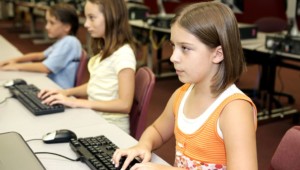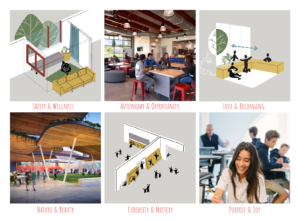Shifting Paradigms to Respond to the Demands of a Global World

College and career ready, 21st-century skills, flipping the classroom, problem-based learning and preparing students to work in a global world permeate the conversations about education in the United States. These discussions are often had with teachers and school leaders in meetings, professional learning opportunities and even in conversations with those outside school systems. These “catch phrases” are really about shifting the paradigm of the traditional classroom and curriculum to respond to the changing world facing today’s students.
In 2005, Friedman published the book “The World is Flat.” Many of us read this book and had “aha” moments as we read. It was as though we hadn’t really noticed that technology had allowed for a new way of working, communicating and sharing information in a micro-second with someone across the world.
While the book shares much more about the changes that come with a global economy, there is little doubt in anyone’s mind in 2016 that the way in which we communicate, shop, learn and work, does not look much like what it did even a decade earlier. So, as educators, we have to make the paradigm shifts necessary to ensure we are bringing the needed skills to our students.
Let’s take a closer look at those “catch phrases”. The discussion on 21st-century skills is often framed into four categories: Collaboration and teamwork, creativity and imagination, critical thinking, and problem-solving. Often, educators think in terms of how to use technology to support these skills within our current classroom paradigms.
Yet, if we are to isolate 21st-century skills to just reframing our current classroom paradigms, we will have missed out on responding to the globalization of the world that our students are destined to work in. The work of TeachThought has offered 4 categories that seem to make it easier to see how to shift the paradigm of classrooms to respond to the needs of a global world: Self-knowledge, human citizenship, critical literacy and transitional literacy.
Self-Knowledge
In order to shift the paradigm, it is important that we offer educators the opportunity to assess their own knowledge of the culturally diversified classrooms of schools today. Once educators are given the opportunity to self-reflect on their own knowledge, schools must then be willing to allow educators the time and the training to fill in those learning gaps. The old adage “You can’t teach what you don’t know” is often forgotten in the quest to shift the paradigm more quickly. This often leads to the resistance that makes changing the curriculum and classrooms almost impossible.
Realization of the need to change most often occurs when someone is allowed time to self- reflect. Therefore, the first step in shifting the paradigm is to allow educators to analyze where they are on a global competency continuum. The University of North Carolina at Chapel Hill has developed a simple tool for doing just that. The Globally Competent Teaching Continuum allows for individuals to gauge their own global competence through self-assessing in 12 categories.
Included in these categories is reflecting on one’s own knowledge of how to assess students in the area of global competence. Once this assessment is completed, an educator can then begin to look for opportunities to close those identified gaps through research, professional learning and sharing with other educators. There are many resources available to support educators from organizations such as the Asia Society, National Educators Association and World Savvy.
Schools that have forged ahead in valuing the idea of creating globally competent students have found their success heightened when they work with problem- or project-based learning. When working with students across all age groups, engaging them in solving a world problem or a globally minded project that involves a place other than the United States forces them to expand their knowledge of other countries beyond “food, flags and festivals.”
Bringing Global Competence to the Classrooms
Let’s think about changing the design of the traditional fourth-grade science unit on weather. Applying the backward planning model to the lesson includes adding a new outcome: Developing the basic global knowledge of students. Once educators determine that this is an essential outcome of the lesson, it can become as important to the learning as the current objectives of the unit. As the primary instruction on cloud formations is completed, the modified lesson includes a new way to assess student learning. Students are to work in groups to look at the cloud formations in different parts of the world through the use of online weather applications.
Once the students have begun to better understand what different types of clouds mean for the upcoming weather, you can have students predict the weather in those regions. Once they have a prediction, students engage in a discussion on the implications for the industries that dominate those countries or regions. While this activity may be considered to be at the global exposure level, you are moving students on a continuum of broadening their knowledge of the world around them. The foundation is being set. The classroom paradigm is beginning to change.
If we think about developing global competence on a continuum, educators can then expand how they work with students across the grade levels and subject areas. As school systems become more globally competent and teachers become more knowledgeable and gain comfort with infusing global competence into the classrooms, students are expected to expand their knowledge incrementally as well.
Engaging high school students in discussions on world historical events can sometimes be difficult. It might be interesting in a high school history class to take textbooks or news articles from both the United States and from other countries to see how they report on an event in history such as the end of World War I, World War II, the resignation of Richard Nixon or the events of 9/11.
From these textbooks/articles, educators can begin to explore the cultural differences between the United States and other countries along with examining how patriotism influences textbooks and articles. The students are charged with becoming investigative reporters, and are asked to determine the accuracy of the texts or articles and discuss what in their background and knowledge is bringing them to their conclusion.
From these textbooks/articles, educators can begin to explore the cultural differences between the United States and other countries along with examining how patriotism influences textbooks and articles. The students are charged with becoming investigative reporters and are asked to determine the accuracy of the texts or articles and discuss what in their background and knowledge is bringing them to their conclusion. Depending on how far you take this assignment, you just might cover all four of the TeachThought components.
The Shift Takes Time
In the end, the shift of a paradigm begins with small changes. Embracing the need to develop a globally competent curriculum and classroom begins with minor adaptations to existing lessons by expanding the countries/regions assigned in existing projects, bringing in articles and source documents from other countries and using available videos and applications that bring the world into the classroom and engage students in global problem solving and expanded discussions. For those who want to see how your own skills and knowledge are changing, commit to taking the self-assessment each semester.
As you see how quickly small changes demonstrate marked improvement in your own journey to become globally competent, you will also see the paradigm of the classroom changing and expanding. That is what we call success!
For more, see:
- Designing Student Projects for Global Readiness
- 3 Teacher Tips for the PBL Paradigm Shift
- Operationalizing Paradigm Shifts in Higher Ed
This post was originally published on EdCircuit.
Dr. Margy Jones-Carey is an Assistant Professor and Program Director for the Educational Leadership Program at St. Bonaventure University. She has been a teacher, principal, assistant superintendent, chief academic officer and more.
Stay in-the-know with all things EdTech and innovations in learning by signing up to receive the weekly Smart Update.






Patti
You say “The discussion on 21st-century skills is often framed into four categories,” yet I see only three listed: 1. Collaboration and teamwork, 2. creativity and imagination, and 3. critical thinking and problem-solving. Is this a case of a missing Oxford comma? Should it be 3. critical thinking and 4. problem-solving?
Replies
Catherine Wedgwood
Hi Patti - Yes, we use AP style on the blog so delete the Oxford comma. However, in this case it does appear to make it confusing, so I've added it back in to distinguish the four categories. Thanks!